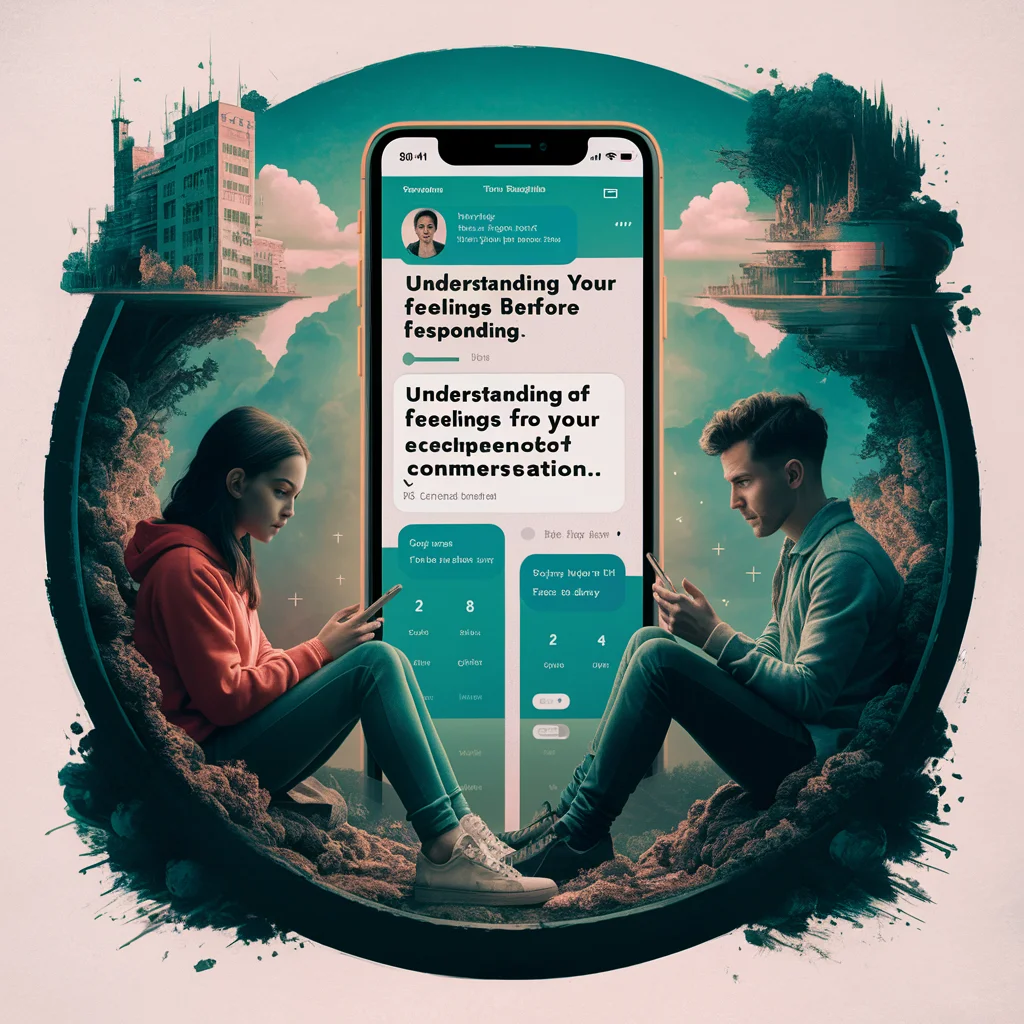Navigating romantic or flirtatious conversations can sometimes be tricky, especially when someone expresses strong feelings, like saying, “I want you so bad.”
Knowing how to respond appropriately based on your mood and the situation can help you manage these interactions with confidence and sensitivity.
This guide explores various responses to “I want you so bad,” tailored to match different moods and contexts.
Whether you’re feeling flattered, shy, overwhelmed, or confident, there’s a way to reply that reflects your feelings and maintains the integrity of your communication.
Understanding Your Feelings Before Responding

Before crafting your response, it’s essential to understand your own feelings.
Explanation:
Are you excited by their message, or does it make you uncomfortable? Take a moment to reflect on your emotions.
For Example:
Assess Your Emotions:
Ask yourself how you genuinely feel about the message. Are you happy, confused, or unsure?
Responding When You Feel Flattered
If their message makes you feel flattered,
Explanation:
you might want to show appreciation while keeping the conversation light and fun.
For Example:
Show Your Gratitude
Wow, that’s such a sweet thing to say! 😊
Replies for When You’re Feeling Romantic
Feeling romantic in return can lead to a more intimate and heartfelt exchange.
Explanation:
Express your mutual feelings with sincerity.
For Example:
Express Your Emotions:
I’ve been thinking about you too, a lot.
How to Respond if You’re Feeling Shy
Shyness can make these situations challenging.
Explanation:
It’s okay to acknowledge your feelings and take it slow.
For Example:
Admit Your Shyness:
I’m a bit shy, but that means a lot to me.
Playful Replies to “I Want You So Bad”
Keeping things playful can maintain a fun atmosphere and show.
Explanation:
your interest without getting too serious too quickly.
For Example:
Tease Back:
Oh really? How bad? 😉
Flirty Responses to Show Your Interest
If you’re interested in them too.
Explanation:
flirty replies can keep the excitement going and show your mutual attraction.
For Example:
Flirt Back:
I want you too, but patience is a virtue. 😉
Serious Replies for a Genuine Connection
Sometimes, a more serious and sincere .
Explanation:
reply is appropriate, especially if you’re looking to deepen your connection.
For Example:
Show Depth:
I really enjoy spending time with you and getting to know you.
How to Respond If You’re Feeling Overwhelmed
If the intensity of their message feels overwhelming
Explanation:
it’s okay to express that and set boundaries.
For Example:
Be Honest:
I’m feeling a bit overwhelmed by your message.
Polite Ways to Decline if You’re Not Interested

It’s important to be respectful and clear.
Explanation:
if you’re not interested in pursuing things further.
For Example:
Be Polite:
I appreciate your feelings, but I don’t think I’m ready for this.
Respectful Replies for Setting Boundaries
Setting boundaries is crucial for maintaining healthy interactions.
Explanation:
Be firm but kind in your response.
For Example:
Be Direct:
I need to set some boundaries regarding our conversations.
Sweet Replies to Show Your Affection
If you want to reciprocate with sweet and affectionate.
Explanation:
replies, express your feelings warmly.
For Example:
Show Affection:
You always know how to make me smile. I feel the same way.
Fun Responses to Keep the Conversation Light
Keeping things fun and light-hearted can be a great way to maintain.
Explanation:
A positive and enjoyable conversation.
For Example:
Be Playful:
You sure know how to brighten my day!
How to Respond if You’re Feeling Nervous
Feeling nervous is natural. Acknowledge your nerves and keep.
Explanation:
the conversation moving at a pace that feels comfortable for you.
For Example:
Admit Your Nerves:
I’m feeling a bit nervous, but that’s really sweet of you to say.
Compassionate Replies for Sensitive Situations
In sensitive situations, showing compassion and understanding.
Explanation:
is key to maintaining respect and empathy.
For Example:
Be Kind:
I understand your feelings, and I want to be honest with you.
Honest Responses When You’re Unsure
If you’re unsure about how you feel.
Explanation:
it’s best to be honest and open about your uncertainty.
For Example:
Be Transparent:
I’m not sure how I feel right now, but I appreciate your honesty.
How to Reply if You’re Not Ready for Commitment
If you’re not ready for a commitment,
Explanation:
it’s important to communicate this clearly and respectfully.
For Example:
Be Clear:
I’m not ready for a serious relationship right now.
Supportive Replies to Show You Care
Show your support and care for the other person, even.
Explanation:
if you’re not ready to reciprocate their feelings fully.
For Example:
Show Support:
I care about you, and I want to be supportive of your feelings.
Respectful Ways to Ask for Space
Asking for space is sometimes necessary to maintain your well-being.
Explanation:
Do so respectfully and kindly.
For Example:
Be Direct:
I need some time and space to think about this.
Encouraging Replies to Keep Things Positive
Encouragement can help maintain a positive tone in your conversation, even.
Explanation:
when discussing serious topics.
For Example:
Be Positive:
I appreciate your honesty, and I think we can work through this together.
Direct Responses When You Want to Be Clear
Sometimes, being direct is the best way to communicate.
Explanation:
your feelings and intentions clearly.
For Example:
Be Straightforward:
I want to be clear about my feelings. I’m not ready for a serious relationship.
Understanding When to Seek More Information
If you need more information before responding,
Explanation:
don’t hesitate to ask for clarity.
For Example:
Ask Questions:
Can you tell me more about how you’re feeling?
How to Respond if You’re Feeling Insecure
Feeling insecure can make it challenging to respond.
Explanation:
Acknowledge your feelings and communicate openly.
For Example:
Admit Your Insecurity:
I’m feeling a bit insecure about this, but I appreciate your honesty.
Kind Replies for Mixed Feelings
Mixed feelings are normal.
Explanation:
Express them kindly and thoughtfully.
For Example:
Be Honest:
I have mixed feelings about this. I need some time to think.
How to Express Your Mutual Interest
If you share their feelings, expressing mutual interest.
Explanation:
can strengthen your connection.
For Example:
Show Enthusiasm:
I feel the same way. I’ve been thinking about you too.
Confident Replies to Show Your Intentions
Confidence can help convey you.
Explanation:
intentions clearly and positively.
For Example:
Be Confident:
I’m interested in you too, and I’d like to see where this goes.
Thoughtful Responses to Show You’re Considering Their Feelings
Showing that you’re considering their feelings.
Explanation:
can create a respectful and empathetic dialogue.
For Example:
Be Thoughtful:
I appreciate your honesty, and I’m taking your feelings into account.
Calm Replies for When You’re Feeling Anxious
Calm replies can help manage anxiety.
Explanation:
keep the conversation steady.
For Example:
Stay Calm:
I’m feeling a bit anxious about this, but I appreciate your honesty.
Creative Ways to Keep the Conversation Going
Creativity can keep the conversation.
Explanation:
lively and engaging.
For Example:
Be Creative:
Let’s plan something fun to do together soon!
Balanced Replies to Keep Things Open
Balanced replies can help maintain an open and honest.
Explanation:
dialogue without rushing into anything.
For Example:
Stay Balanced:
I’m interested in you, but I want to take things one step at a time.
Empowering Responses to Maintain Your Independence
Maintaining your independence while expressing interest.
Explanation:
is crucial for a healthy relationship.
For Example:
Be Empowering:
I’m interested in you, but I also value my independence.

Nicholas Clark is the visionary behind ReplySwift.com. With a talent for crafting concise and impactful responses, Nicholas helps others communicate with clarity and confidence. On ReplySwift.com, he provides expert advice, practical templates, and valuable insights to enhance every reply.












